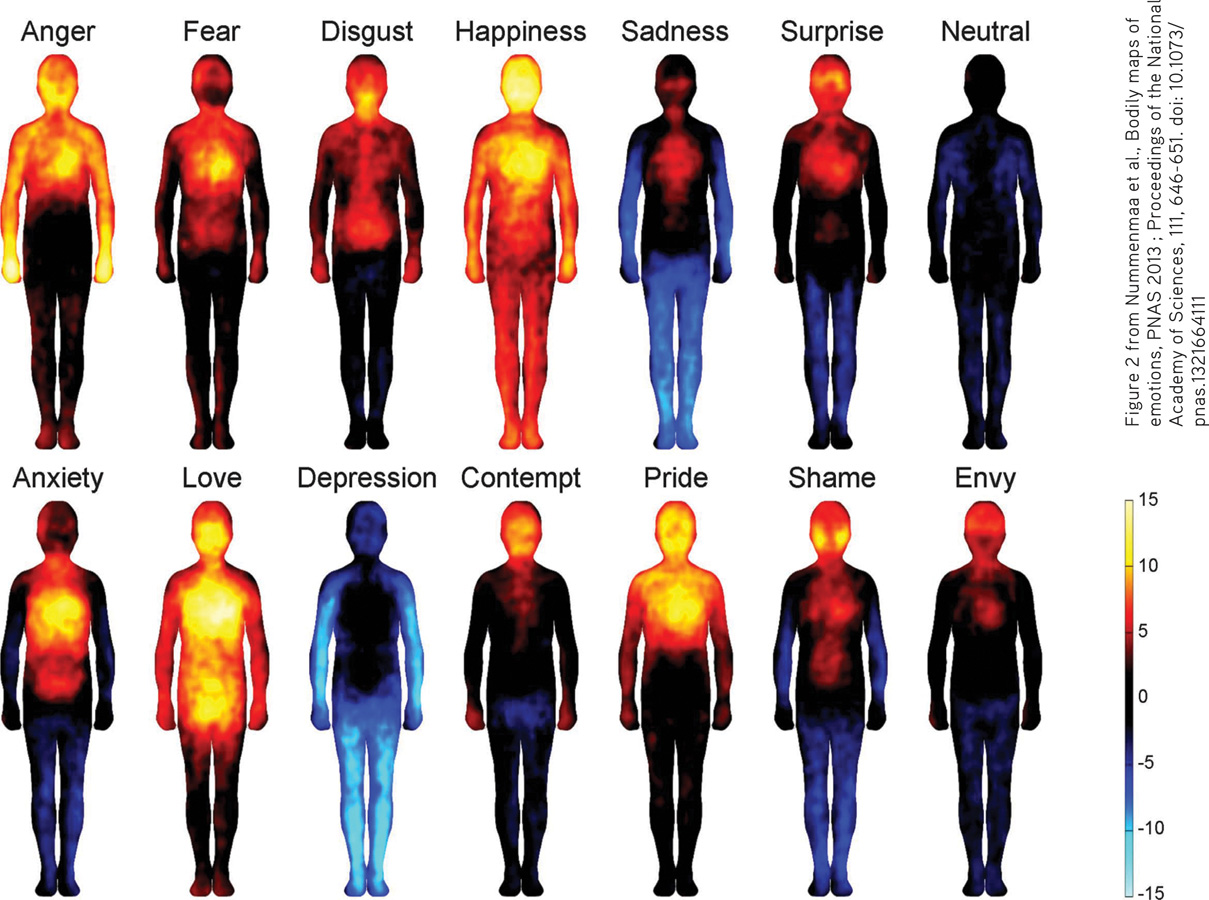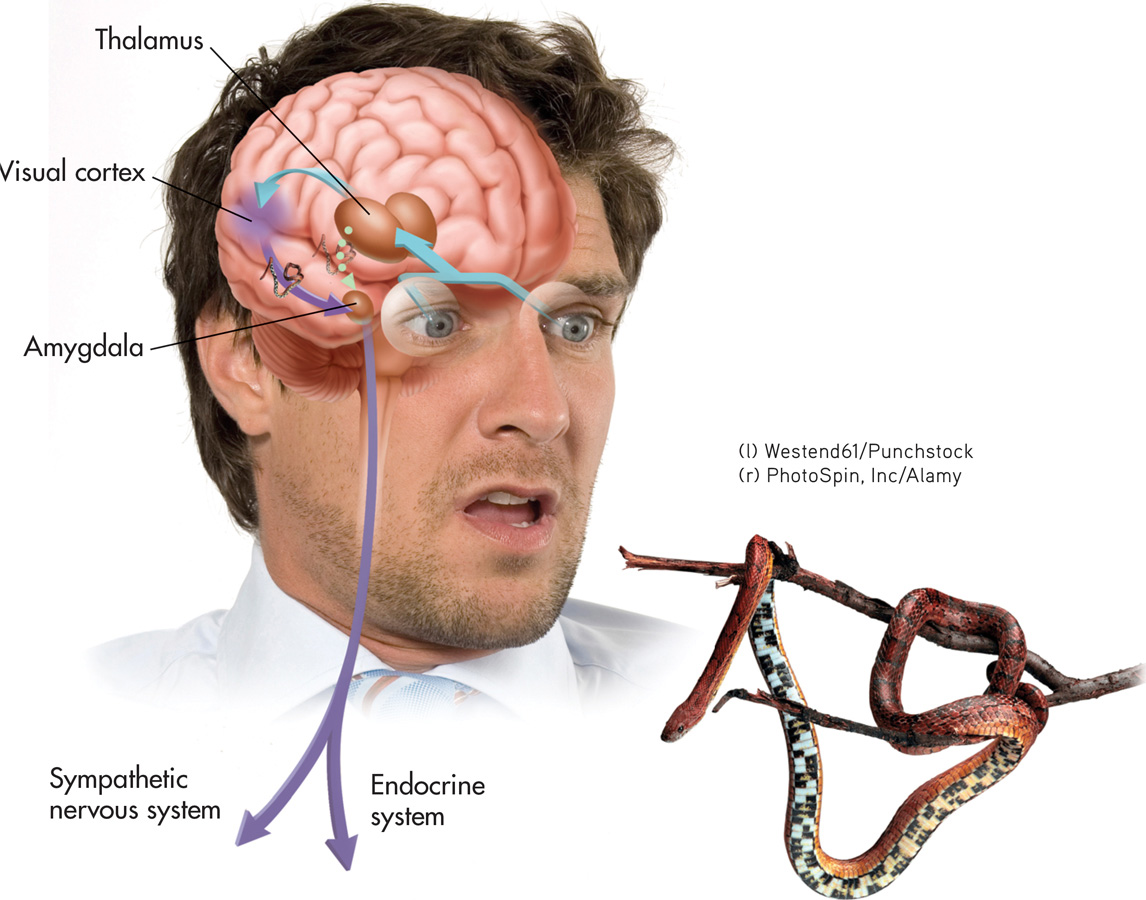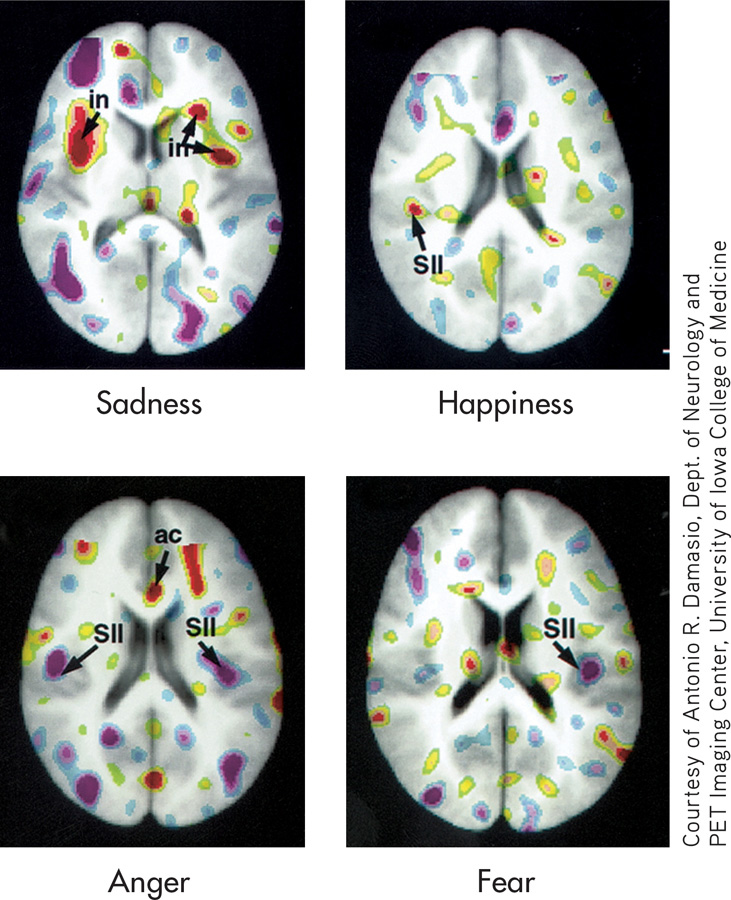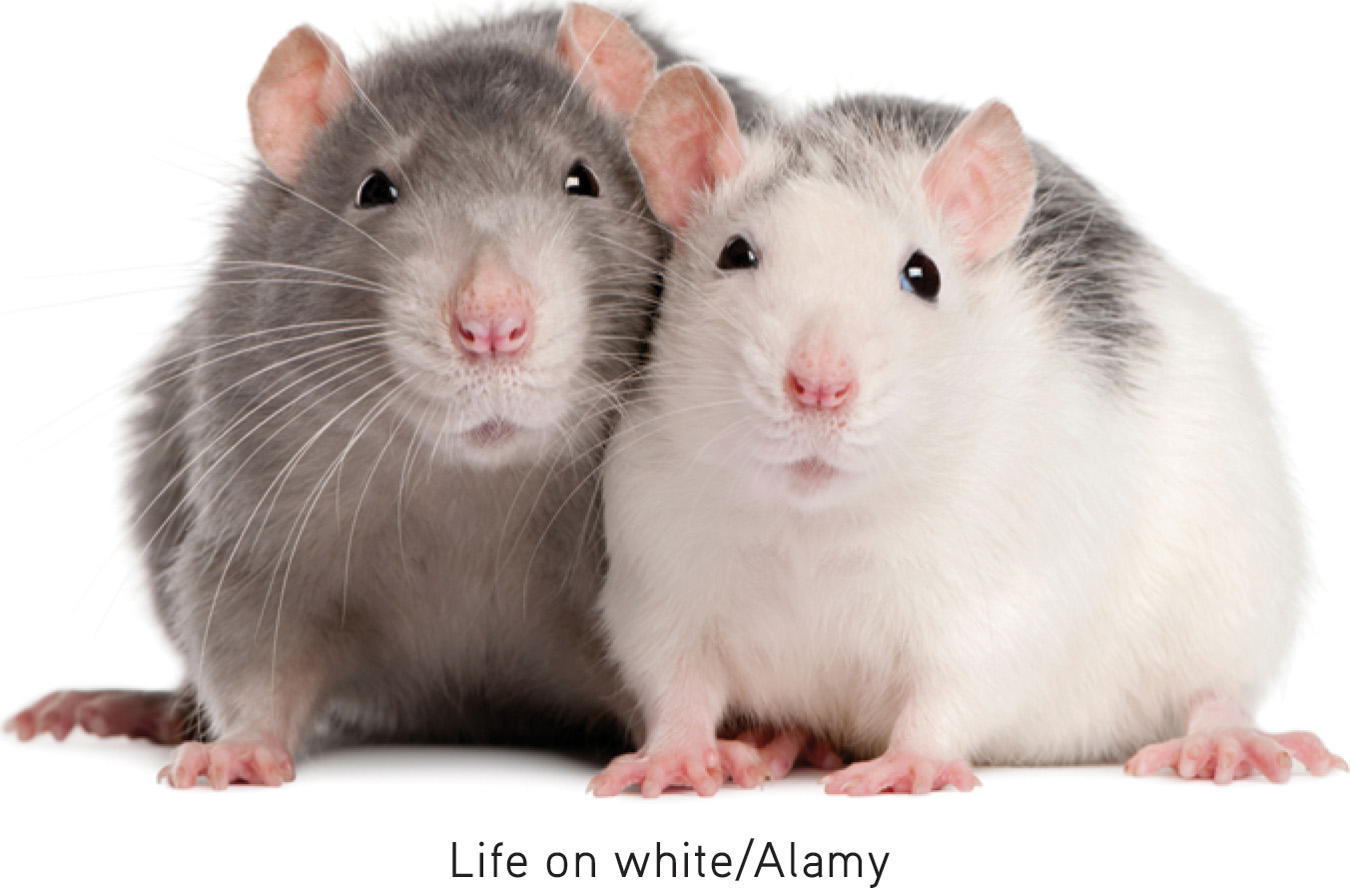8.5 The Neuroscience of Emotion
KEY THEME
Emotions are associated with distinct patterns of responses by the sympathetic nervous system and in the brain.
KEY QUESTIONS
How is the sympathetic nervous system involved in intense emotional responses?
What brain structures are involved in emotional experience, and what neural pathways make up the brain’s fear circuit?
How does the evolutionary perspective explain the dual brain pathways for transmitting fear-related information?
Psychologists have long studied the physiological aspects of emotion. Early research focused on the autonomic nervous system’s role in triggering physiological arousal. More recently, brain imaging techniques have identified specific brain regions involved in emotions. In this section, we’ll look at both areas of research.
EMOTION AND THE SYMPATHETIC NERVOUS SYSTEM: HOT HEADS AND COLD FEET
The pounding heart, rapid breathing, trembling hands and feet, and churning stomach that occur when you experience an intense emotion like fear reflect the activation of the sympathetic branch of the autonomic nervous system. When you are threatened, the sympathetic nervous system triggers the fight-or-flight response, a rapidly occurring series of automatic physical reactions. Breathing and heart rate accelerate, and blood pressure surges. You perspire, your mouth goes dry, and the hairs on your skin may stand up, giving you the familiar sensation of goose bumps. Your pupils dilate, allowing you to take in a wider visual field. Blood sugar levels increase, providing a burst of energy. Digestion stops as blood is diverted from the stomach and intestines to the brain and skeletal muscles, sometimes causing the sensations of light-headedness or “butterflies” fluttering in your stomach. The polygraph, or “lie detector,” measures these physiological reactions associated with emotional arousal (see the In Focus box, “Detecting Lies”).
The sympathetic nervous system is also activated by other intense emotions, such as excitement, passionate love, or extreme joy. If you’ve ever ridden an exciting roller coaster, self-consciously given a speech in front of your peers, or been reunited with a loved one after a long absence, you’ve experienced the high levels of physiological arousal that can be produced by other types of emotions. Obviously, not all emotions involve intense physical reactions. And some emotions, such as contentment, are characterized by decreased physical arousal and the slowing of some body processes (Levenson & others, 1990, 1992).
Think Like a SCIENTIST
Can you learn to tell when someone is lying? Go to LaunchPad: Resources to Think Like a Scientist about Lie Detection.

IN FOCUS
Detecting Lies
The polygraph, commonly called a lie detector, doesn’t really detect lies or deception. Rather, a polygraph measures physiological changes associated with emotions like fear, tension, and anxiety. Heart rate, blood pressure, respiration, and other indicators are monitored during a polygraph interview. The polygraph is based on the assumption that lying is accompanied by anxiety, fear, and stress. When people show arousal patterns typically associated with anxiety or fear, lying is inferred (Grubin, 2010; Meijer & Verschuere, 2010).
MYTH !lhtriangle! SCIENCE
Is it true that polygraphs, or lie detector tests, are a valid way to detect lying?
There are many potential problems with using a polygraph to detect lying. First, there is no unique pattern of physiological arousal associated specifically with lying (Vrij & others, 2010). Second, some people can lie without experiencing anxiety or arousal. This produces a false negative result—the liar is judged to be telling the truth. Third, people may be innocent of any wrongdoing but still be fearful or anxious when asked incriminating questions—especially if they believe that they are suspected of a crime. Truth-tellers can be as nervous as liars, especially if they have reason to believe that negative consequences will follow if they are disbelieved (Vrij & others, 2010). This can lead to false positive results—innocent people are judged as being guilty. In fact, polygraph tests are more likely to wrongly identify innocent people as guilty than guilty people as innocent (Bashore & Rapp, 1993; National Research Council, 2003).

Finally, interpreting polygraph results can be highly subjective. In one study, polygraph results were compared to later confessions of guilt in criminal cases. Lying was accurately detected by the polygraph examiners at a rate just slightly better than flipping a coin (Phillips, 1999).
In the scientific community, it is generally agreed that polygraphs are not a valid method to detect lies and that their results should not be used as evidence (National Research Council, 2003). Because of the polygraph’s high error rate, many states do not allow polygraph tests as evidence in court. However, the U.S. government uses polygraph testing in several agencies, including the CIA and the Department of Energy (Holden, 2001).
Microexpressions: Fleeting Indicators of Deceit
Emotion researcher Paul Ekman (2003) has found that deception is associated with a variety of nonverbal cues, such as fleeting facial expressions, vocal cues, and nervous body movements. Especially revealing are the fleeting facial expressions, called microexpressions, that last about 1/25 of a second. When people lie and try to control their facial expressions, microexpressions of fear, guilt, or anxiety often “leak” through (Ekman & O’Sullivan, 2006). Even so, no single nonverbal cue indicates that someone is lying. However, people who are skilled at decoding nonverbal cues—like clinical psychologists—are better than other people at detecting deception (Bond, 2008; Ekman & others, 1999).
Research has shown that there are differing patterns of physiological arousal for different emotions (Ekman, 2003). In one series of studies, psychologist Robert W. Levenson (1992) found that fear, anger, and sadness are all associated with accelerated heart rate. But comparing anger and fear showed differences that confirm everyday experience. Anger produces greater increases in blood pressure than fear. And while anger produces an increase in skin temperature, fear produces a decrease in skin temperature. Perhaps that’s why when we are angry, we speak of “getting hot under the collar,” and when fearful, we feel clammy and complain of having “cold feet.”

Levenson (1992, 2003) believes that these differing patterns of sympathetic nervous system activation are universal, reflecting biological responses to the basic emotions that are hard-wired by evolution into all humans. Supporting this contention, Levenson found that male and female subjects, as well as young and elderly subjects, experience the same patterns of autonomic nervous system activity for different basic emotions. These distinctive patterns of emotional physiological arousal were also found in members of a remote culture in western Sumatra, an island in Indonesia (Levenson & others, 1992).
Broader surveys of different cultures have also demonstrated that the basic emotions are associated with distinct patterns of autonomic nervous system activity (Levenson, 2003; Scherer & Wallbott, 1994). It seems that people in different cultures associate certain patterns of physical sensations with certain emotions. When asked to describe the way that basic emotions such as fear, anger, sadness, and happiness “felt” in the body, Finnish psychologist Lauri Nummenmaa and his colleagues (2014) found a high degree of agreement in participants from Finland, Sweden, and Taiwan (see FIGURE 8.4).

If you’d like to participate in the experiment, you can try it here: http://becs.aalto.fi/∼lnummen/participate.htm
Question 8.14
2VPxBRV+GSta9JnBhp6LCV47hSgWI8YF5IoXqVklUT9YQWvsZTEPtdDfgSsJDmJTu9+zrOQ2U9fymHnndbydWjJke0mMne8c+uaK9+ETBiN2S4gCjQCPuhcqb0R/avK80Aa0maicQMsuPvsJV3ReJuecU3EXaaOQ3AUK/wi2ADrxafdJ8W5mPQ2P9ibtGkLbFvFC1g3NkRxwzTEyPGK42AADaEJ46+kwKW1jaT8vAbAe49Mh8FI+LFCztpJqdKMRvxPBO/mkFsZE0tmQWrK2bxW8GKr3LXObWnEMMZ62S9pffvIsm6/e7XFAr6u2k+tw8wUG2ALKPOYNl6fQ3g+n21yBA+YX2y/uolGlWQv4iMcLzKIDAlY2SZRTUTCcHZHFjuNYGZieb5U=THE EMOTIONAL BRAIN: FEAR AND THE AMYGDALA
Sophisticated brain imaging techniques have led to an explosion of new knowledge about the brain’s role in emotion. Of all the emotions, the brain processes involved in fear have been most thoroughly studied. Many brain areas are implicated in emotional responses, but the brain structure called the amygdala has long been known to be especially important. As described in Chapter 2, the amygdala is an almond-shaped cluster of neurons located deep in the temporal lobe on each side of the brain. The amygdala is part of the limbic system, a group of brain structures involved in emotion, memory, and basic motivational drives, such as hunger, thirst, and sex. Neural pathways connect the amygdala with many other brain structures (Cunningham & Brosch, 2012; Pessoa & Adolphs, 2010).
amygdala
(uh-MIG-dull-uh) An almond-shaped cluster of neurons in the brain’s temporal lobe, involved in memory and emotional responses, especially fear.

Several studies have shown that the amygdala is a key brain structure in the emotional response of fear in humans (LeDoux, 2007). For example, brain imaging techniques have demonstrated that the amygdala activates when you view threatening or fearful faces, or hear people make nonverbal sounds expressing fear (Morris & others, 1999; Öhman & others, 2007). Even when people simply anticipate a threatening stimulus, the amygdala activates as part of the fear circuit in the brain (Phelps & others, 2001).
In rats, amygdala damage disrupts the neural circuits involved in the fear response. For example, rats with a damaged amygdala can’t be classically conditioned to acquire a fear response (LeDoux, 2007). In humans, damage to the amygdala also disrupts elements of the fear response. For example, people with amygdala damage lose the ability to distinguish between friendly and threatening faces (Adolphs & others, 1998).
Activating the Amygdala: Direct and Indirect Neural Pathways Let’s use an example to show how the amygdala participates in the brain’s fear circuit. Imagine that your sister’s eight-year-old son sneaks up behind you at a family picnic and pokes you in the back with a long stick. As you quickly wheel around, he shouts, “Look what I found in the woods!” Dangling from the stick is a wriggling, slimy-looking, three-foot-long snake. He tosses the snake into your face, and you let out a yell and jump two feet into the air. As he bursts into hysterical laughter, you quickly realize that the real-looking snake is made of rubber, your nephew is a twit, and your sister is laughing as hard as her son.
Even if you don’t know any obnoxious eight-year-old boys, you’ve probably experienced a sudden fright in which you instantly reacted to a threatening stimulus, like a snake, a spider, or an oncoming car. Typically, you respond instinctively, without taking time to consciously or deliberately evaluate the situation.
So how can we respond to potentially dangerous stimuli before we’ve had time to think about them? Let’s stay with our example. When you saw the dangling snake, the visual stimulus was first routed to the thalamus (see FIGURE 8.5). As we explained in Chapter 2, all incoming sensory information, with the exception of olfactory sensations, is processed in the thalamus before being relayed to sensory centers in the cerebral cortex.

However, the neuroscientist Joseph LeDoux (1996, 2000) discovered that there are two neural pathways for sensory information that project from the thalamus. One leads to the cortex, as previously described, but the other leads directly to the amygdala, bypassing the cortex. When we are faced with a potential threat, sensory information about the threatening stimulus is routed simultaneously along both pathways.
LeDoux (1996) describes the direct thalamus→amygdala pathway as a “shortcut” from the thalamus to the amygdala. This is a “quick-and-dirty” route that transmits crude, almost archetypal, information about the stimulus directly to the amygdala. This rapid transmission allows the brain to start to respond to the possible danger represented by a writhing, curved snake dangling from a stick before you have time to consciously think about the stimulus. The amygdala activates and triggers the brain’s alarm system.
What happens next? The amygdala sends information along neural pathways that project to other brain regions that make up the rest of the brain’s fear circuit. One pathway leads to an area of the hypothalamus, then on to the medulla at the base of the brain. In combination, the hypothalamus and medulla trigger arousal of the sympathetic nervous system. Another pathway projects from the amygdala to a different hypothalamus area that, in concert with the pituitary gland, triggers the release of stress hormones (LeDoux, 1995, 2000).
The result? You respond instantly to the threat—“SNAKE!”—by leaping backward, heartbeat and breathing accelerating. But even as you respond to the threat, information is speeding along the other neural pathway that reaches the amygdala by traveling through the cortex. The thalamus sends information to the visual cortex, which creates a detailed and more accurate representation of the visual stimulus. You can also reevaluate the signal that prompted the initial instinctive response. Now you realize that the “snake” is actually just a rubber toy. The cortex sends the “false alarm” message to the amygdala. But note that information traveling the thalamus→cortex→amygdala route takes about twice as long to reach the amygdala as the information traveling along the direct thalamus→amygdala route. Thus, the alarm reaction is already in full swing before signals from the cortex reach the amygdala.
FOCUS ON NEUROSCIENCE
Emotions and the Brain
Do Different Emotions Activate Different Brain Areas?
The idea that different combinations of brain regions are activated by different emotions received considerable support in a brain imaging study by neuroscientist Antonio Damasio and his colleagues (2000). In the study, participants were scanned using positron emission tomography (PET) while they recalled emotionally charged memories to generate feelings of sadness, happiness, anger, and fear.

Each of the four PET scans shown here is an averaged composite of all 39 participants in the study. Significant areas of brain activation are indicated in red, while significant areas of deactivation are indicated in purple. Notice that sadness, happiness, anger, and fear each produced a distinct pattern of brain activation and deactivation. These findings confirmed the idea that each emotion involves distinct neural circuits in the brain. Other research has produced similar findings (Dalgleish, 2004; Vytal & Hamann, 2010).
One interesting finding in the Damasio study was that the emotional memory triggered autonomic nervous system activity and physiological arousal before the volunteers signaled that they were subjectively “feeling” the target emotion. Areas of the somatosensory cortex, which processes sensory information from the skin, muscles, and internal organs, were also activated. These sensory signals from the body’s peripheral nervous system contributed to the overall subjective “feeling” of a particular emotion. Remember Damasio’s findings because we’ll refer to this study again when we discuss theories of emotion.
LeDoux believes these dual alarm pathways serve several adaptive functions. The direct thalamus→amygdala pathway rapidly triggers an emotional response to threats that, through evolution, we are biologically prepared to fear, such as snakes, snarling animals, or rapidly moving, looming objects. In contrast, the indirect pathway allows more complex stimuli to be evaluated in the cortex before triggering the amygdala’s alarm system. So, for example, the gradually dawning awareness that your job is in jeopardy as your boss starts talking about the need to reduce staff in your department probably has to travel the thalamus→cortex→amygdala pathway before you begin to feel the cold sweat break out on your palms.
In situations of potential danger, it is clearly advantageous to be able to respond quickly. According to LeDoux (1995, 2000), the direct thalamus→amygdala connection represents an adaptive response that has been hard-wired by evolution into the human brain. From the point of view of survival, as LeDoux (1996) remarks, “The time saved by the amygdala in acting on the thalamic interpretation, rather than waiting for the cortical input, may be the difference between life and death.”
In support of this evolutionary explanation, Swedish psychologist Arne Öhman and his colleagues (2001; Schupp & others, 2004) have found that people detect and react more quickly to angry or threatening faces than they do to friendly or neutral faces. Presumably, this reflects the faster processing of threatening stimuli via the direct thalamus→amygdala route (Lundqvist & Öhman, 2005).
The Expression of Emotion: MAKING FACES
KEY THEME
The behavioral components of emotion include facial expressions and nonverbal behavior.
KEY QUESTIONS
What evidence supports the idea that facial expressions for basic emotions are universal?
How does culture affect the behavioral expression of emotion?
How can emotional expression be explained in terms of evolutionary theory?
Every day, we witness the behavioral components of emotions in ourselves and others. We laugh with pleasure, slam a door in frustration, or frown at a clueless remark. But of all the ways that we express and communicate our emotional responses, facial expressions are the most important.
In The Expression of the Emotions in Man and Animals, Darwin (1872) argued that human emotional expressions are innate and culturally universal. He also noted the continuity of emotional expression between humans and many other species, citing it as evidence of the common evolutionary ancestry of humans and other animals. But do nonhuman animals actually experience emotions? We explore this question in the Critical Thinking box, “Emotion in Nonhuman Animals: Laughing Rats, Silly Elephants, and Smiling Dolphins?”

Of course, humans are the animals that exhibit the greatest range of facial expressions. Psychologist Paul Ekman has studied the facial expression of emotions for more than four decades. Ekman (1980) estimates that the human face is capable of creating more than 7,000 different expressions. This enormous flexibility allows us considerable versatility in expressing emotion in all its subtle variations.
To study facial expressions, Ekman and his colleague Wallace Friesen (1978) coded different facial expressions by painstakingly analyzing the facial muscles involved in producing each expression. In doing so, they precisely classified the facial expressions that characterize the basic emotions of happiness, sadness, surprise, fear, anger, and disgust. When shown photographs of these facial expressions, research participants were able to correctly identify the emotion being displayed (Ekman, 1982, 1992b, 1993).
CRITICAL THINKING
Emotion in Nonhuman Animals: Laughing Rats, Silly Elephants, and Smiling Dolphins?
Do animals experience emotions? If you’ve ever frolicked with a playful puppy or shared the contagious contentment of a cat purring in your lap, the answer seems obvious. But before you accept that answer, remember that emotion involves three components: physiological arousal, behavioral expression, and subjective experience. In many animals, fear and other “emotional” responses appear to involve physiological and brain processes that are similar to those involved in human emotional experience. In mammals, it’s also easy to observe behavioral responses when an animal is menaced by a predator or by the anger in aggressive displays. But what about subjective experience?
Darwin on Animal Emotions
Charles Darwin never doubted that animals experienced emotions. In his landmark work The Expression of the Emotions in Man and Animals, Darwin (1872/1998) contended that differences in emotional experience between nonhuman animals and humans are a matter of degree, not kind. “The lower animals, like man, manifestly feel pleasure and pain, happiness and misery,” he wrote in The Descent of Man in 1871. From Darwin’s perspective, the capacity to experience emotion is yet another evolved trait that humans share with lower animals (Bekoff, 2007).


One problem in establishing whether animals experience emotion is the difficulty of determining the nature of an animal’s subjective experience (Kuczaj, 2013). Even Darwin (1871/1981) readily acknowledged this problem, writing, “Who can say what cows feel, when they surround and stare intently on a dying or dead companion?”
Anthropomorphism: Happy Dolphins?
Despite the problem of knowing just what an animal is feeling, we often think that we do. For example, one reason that dolphins are so appealing is the wide, happy grin they seem to wear. But the dolphin’s “smile” is not a true facial expression—it’s simply the bony curvature of its mouth. If you comment on the friendly, happy appearance of the dolphins frolicking at SeaWorld or another aquarium, you’re projecting those human emotions onto the dolphins.
You also just committed anthropomorphism—you attributed human traits, qualities, or behaviors to a nonhuman animal. The tendency of people to be anthropomorphic is understandable when you consider how extensively most of us were conditioned as children via books, cartoons, and Disney characters to believe that animals are just like people, only with fur or feathers.
anthropomorphism
The attribution of human traits, motives, emotions, or behaviors to nonhuman animals or inanimate objects.

From a scientific perspective, anthropomorphism can hinder progress in understanding animal emotions. By assuming that an animal thinks and feels as we do, we run the risk of distorting or obscuring the reality of the animal’s own unique experience (de Waal, 2011; Hauser, 2000). Instead, we must acknowledge that other animals are not happy or sad in the same way that humans subjectively experience happiness or sadness.
Animals clearly demonstrate diverse emotions—fear, anger, surprise. But to understand how they subjectively experience such feelings—and, indeed, whether they do at all—raises questions that cannot be fully answered at this time. Nonetheless, it seems safe to assume that more primitive animals, like fish, turtles, and snakes, probably do not possess a level of self-awareness that would allow them to experience complex emotions like grief, empathy, or altruism (Hauser, 2000). For more sophisticated animals, like dolphins, primates, and elephants, the evidence is more compelling (Bekoff, 2007; Lyn & Savage-Rumbaugh, 2013; Kuczaj & others, 2013).
One subjective aspect of the scientific method is how to interpret evidence and data. In the case of the evidence for animal emotions, the scientific debate is far from over. Although the lack of a definitive answer can be frustrating, keep in mind that such scientific debates play an important role in avoiding erroneous conclusions and shaping future research.
CRITICAL THINKING AND QUESTIONS
What evidence would lead you to conclude that primates, dolphins, or elephants experience emotions?
Would you accept different evidence to conclude that a 6-month-old human infant can experience emotions? If so, why?
Is it possible to be completely free of anthropomorphic tendencies in studying animal emotions?
Ekman concluded that facial expressions for the basic emotions are innate and probably hard-wired in the brain. Further evidence comes from children who are born blind and deaf. Despite their inability to observe or hear others, they express joy, anger, and pleasure using the same expressions as sighted and hearing children (Goodenough, 1932; Matsumoto & Hwang, 2011b). Similarly, the spontaneous facial expressions of children and young adults who were born blind do not differ from those of sighted children and adults (Galati & others, 1997, 2003).
!launch!

CULTURE AND EMOTIONAL EXPRESSION
Facial expressions for the basic emotions seem to be universal across different cultures (Waller & others, 2008). Ekman (1982) and other researchers showed photographs of facial expressions to people in 21 different countries. Despite their different cultural experiences, all the participants identified the emotions being expressed with a high degree of accuracy (see Ekman, 1998). Even the inhabitants of remote, isolated villages in New Guinea, who had never been exposed to movies or other aspects of Western culture, were able to identify the emotions being expressed. Other research has confirmed and extended Ekman’s original findings (see Elfenbein & Ambady, 2002; Frank & Stennett, 2001).
Other aspects of emotional expression, such as tone of voice and nonverbal expression, also seem to be easily understood across widely different cultures. As anyone who has ever been the target of a sarcastic remark is well aware, the human voice very effectively conveys emotional messages. Several studies have found that people from different cultures can accurately identify the emotion being expressed by tone of voice alone, even when the actual words used were unintelligible (Russell & others, 2003; Scherer & others, 2001). Similarly, people from different cultures were able to accurately evaluate the emotional content of video clips depicting an emotional conversation between two people, even though the dialogue was scrambled (Sneddon & others, 2011). And, some body language seems to be universal.
However, some specific nonverbal gestures, which are termed emblems, vary across cultures. For example, shaking your head means “no” in the United States but “yes” in southern India and Bulgaria. Nodding your head means “yes” in the United States, but in Japan it could mean “maybe” or even “no way!”
In many situations, you adjust your emotional expressions to make them appropriate in that particular social context. For example, even if you are deeply angered by your supervisor’s comments at work, you might consciously restrain yourself and maintain a neutral facial expression. How, when, and where we display our emotional expressions are strongly influenced by cultural norms. Cultural differences in the management of facial expressions are called display rules (Ekman & others, 1987; Ambady & others, 2006).
display rules
Social and cultural regulations governing emotional expression, especially facial expressions.

Consider a classic experiment in which a hidden camera recorded the facial expressions of Japanese and Americans as they watched films that showed grisly images of surgery, amputations, and so forth (Ekman & others, 1987; Friesen, 1972). When they watched the films alone, the Japanese and American participants displayed virtually identical facial expressions, grimacing with disgust and distaste at the gruesome scenes. But when a scientist was present while the participants watched the films, the Japanese masked their negative facial expressions of disgust or fear with smiles. Why? In Japan an important display rule is that you should not reveal negative emotions in the presence of an authority figure so as not to offend the higher-status individual.
Display rules can also vary for different groups within a given culture. For example, recall our earlier discussion about gender differences in emotional expression. In many cultures, including the United States, women are allowed a wider range of emotional expressiveness and responsiveness than men (Fischer & others, 2004). For example, for men, it’s considered “unmasculine” to be too open in expressing certain emotions, such as sadness (Johnson & others, 2011). Crying is especially taboo (Vingerhoets & others, 2000).
MYTH !lhtriangle! SCIENCE
Is it true that facial expressions, such as smiles, are learned and vary from one culture to another?
So what overall conclusions emerge from the research findings on emotional expressions? First, Paul Ekman and other researchers have amassed considerable evidence that facial expressions for the basic emotions—happiness, sadness, anger, fear, surprise, and disgust—are hard-wired into the brain. They also contend that the basic emotions are biologically determined, the result of evolutionary processes. Second, these emotional expressions serve the adaptive function of communicating internal states to friends and enemies. Like the survival of other social animals, human survival depends on being able to recognize and respond quickly to the emotional state of others. Third, although facial expressions for the basic emotions may be biologically programmed, cultural conditioning, gender-role expectations, and other learning experiences shape how, when, and whether emotional responses are displayed.